Training For Your Trip
Get ready for your trip by being physically fit enough to have the time of your life.
When it comes to training, our mantra at Wildland Trekking is “the more physically prepared you are, the more fun you’ll have.” Training for your Wildland trip is about more than safety; it’s about enjoyment. Without training, many people may be able to complete the trip but by being in the best shape possible for your adventure you’ll maximize the fun!
IMPORTANT: The more physically prepared you are, the more fun you’ll have on your trip!

TRAINING BY HIKING
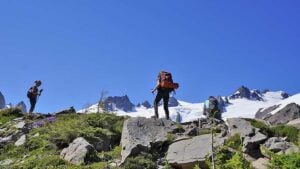 If you have access to hiking trails in hilly or mountainous terrain, this is the ideal way to train. If not, we recommend using the Stairmaster machine (with rotating stairs like an escalator) or actually training on stairs. Nothing prepares you for a trip better than the activity itself!
If you have access to hiking trails in hilly or mountainous terrain, this is the ideal way to train. If not, we recommend using the Stairmaster machine (with rotating stairs like an escalator) or actually training on stairs. Nothing prepares you for a trip better than the activity itself!
Train at least 3 days a week. Start with short hikes or workouts (1-hour in length) with a light daypack. From week to week build the length and intensity of your hikes/workouts and gradually increase your pack weight until you’re comfortably able to hike 6-8 hours a day carrying the weight you’ll have on your trip. It’s best to begin your training regimen at least 12 weeks prior to your trip. Also be sure to use the boots you’ll have on your trip to break them in.
Following is how a program may look:
| First Week | Work Up To |
| Tuesday: 1-hour hike/workout with daypack Thursday: 1-hour hike/workout with daypack Sunday: 2-hour hike/workout with daypack |
Monday: 2-3 hour hike/workout with daypack Wednesday: 2-3 hour hike/workout with daypack Thursday: 2-3-hour hike/workout with daypack Sunday: 7-hour hike with the weight you’ll have on your trip (noted in your trip packet) |
CLIMBING STAIRS
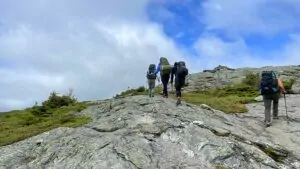 Rangers and guides agree that stair climbing is the most effective way to simulate hiking in areas with significant and sustained elevation gains and losses such as Grand Canyon, the Tetons, the North Cascades, the Himalayas, the Alps…etc. (Trails in the Grand Canyon specifically are steep and continuous, with long sections of steps. The combination can take a surprising toll on hikers.)
Rangers and guides agree that stair climbing is the most effective way to simulate hiking in areas with significant and sustained elevation gains and losses such as Grand Canyon, the Tetons, the North Cascades, the Himalayas, the Alps…etc. (Trails in the Grand Canyon specifically are steep and continuous, with long sections of steps. The combination can take a surprising toll on hikers.)
Train by climbing up and down stairs with a pack for one to three hours each day three times per week. Find a place where you can climb many flights of stairs in a single go such as a stadium or tall building. Otherwise climb the stairs at your office, house, park, or neighborhood. Begin your training at least 12 weeks prior to your trip and gradually increase the weight in your pack until you’re carrying the weight you’ll have on your trip (noted in your trip packet). Specifically for the Grand Canyon, it’s beneficial to take an elevator to the top of a tall building and walk down the stairs rather than up and down, to simulate the long descent into the Canyon. This will help build the strength you’ll need not just for descending but for going up as well.
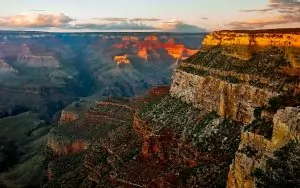
Note About Grand Canyon Backpacking Trips
The physical demands of backpacking the Grand Canyon are unique. The first part of the hike is a knee-jarring descent, and the climb out comes when your legs are fatigued from multiple days of hiking, all with a 25-45 pound backpack (exact pack weight depends on your body size and trip). And you’ll ascend into thinner air as you near the rim at 7,000 feet, causing many people to get out of breath more easily.
Adequate training is absolutely critical on Grand Canyon backpacking trips. Please train and be prepared!
GYM TRAINING
 If a hiking routine is not practical you can adequately train for your trip in the gym. Be sure to begin exercising 3 times a week at a minimum for at least 30 minutes each time. Gradually increase the length and intensity of your workouts during the time you’re training for the trip. A program that improves your cardiovascular fitness and strength in all muscle groups is best for backpacking.
If a hiking routine is not practical you can adequately train for your trip in the gym. Be sure to begin exercising 3 times a week at a minimum for at least 30 minutes each time. Gradually increase the length and intensity of your workouts during the time you’re training for the trip. A program that improves your cardiovascular fitness and strength in all muscle groups is best for backpacking.
Activities may include swimming, step aerobics, treadmill, bicycling, or elliptical trainers to name a few. Swimming is a great way to build endurance and cardiovascular fitness and is easy on the joints. A modest weight training program focusing on the muscles that support the ankles, knees, back, and shoulders is also beneficial.
SUPPLEMENTAL TRAINING IDEAS
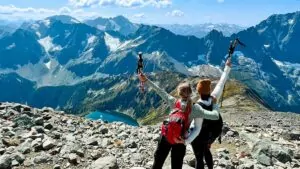 There are many other activities that are easily incorporated into your daily life to build your overall fitness. Cross training is important to strengthen opposing muscle groups and it helps to avoid over-use injuries. Supplemental training ideas include:
There are many other activities that are easily incorporated into your daily life to build your overall fitness. Cross training is important to strengthen opposing muscle groups and it helps to avoid over-use injuries. Supplemental training ideas include:
- Bike to work or when running errands.
- Swimming is a great way to build endurance and cardiovascular fitness and is easy on the joints.
- Walk to work instead of driving. Run your errands by walking and carry your groceries home in a backpack.
- Yoga and/or Pilates classes can build strength throughout your body while also improving your flexibility.
- Intramural sports
- Jogging is another option, however if you are not a regular runner it can easily lead to injuries that backpacking may then exacerbate. Undertake a jogging routine with care.
FLEXIBILITY AND HYDRATION
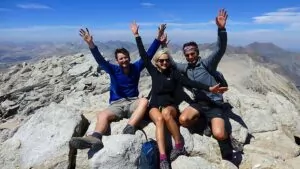 Flexibility is an important part of training. Remember to stretch before and after your workouts. For the two weeks leading up to your trip cut your workouts in half to avoid arriving fatigued. Also for a 72-hour period before your trip commences, ensure that you are consuming sufficient amounts of sodium and fluids. Doctors agree that hikers increase the likelihood of experiencing problems if they are sodium depleted (e.g., follow a low sodium diet) or are dehydrated (due to travel or using diuretics such as coffee or alcohol).
Flexibility is an important part of training. Remember to stretch before and after your workouts. For the two weeks leading up to your trip cut your workouts in half to avoid arriving fatigued. Also for a 72-hour period before your trip commences, ensure that you are consuming sufficient amounts of sodium and fluids. Doctors agree that hikers increase the likelihood of experiencing problems if they are sodium depleted (e.g., follow a low sodium diet) or are dehydrated (due to travel or using diuretics such as coffee or alcohol).
Important note: Always consult with your physician before commencing with a workout program.



